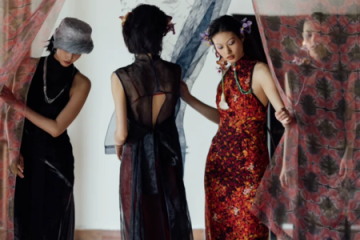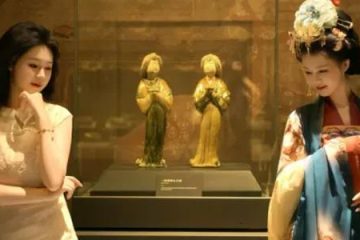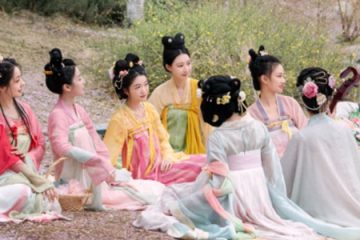The Differences in Body Postures in Ancient Costume Dramas Are Staggering!

Recently, the issue of body postures of actors in two popular ancient costume dramas has once again become a hot topic. Why do people care so much about body postures? Well, body postures are of utmost importance, whether for actors in period dramas or those who wear Hanfu dress. Imagine you’ve spent a lot of time and effort putting together a complete Hanfu ensemble, excited to go out and take beautiful photos. But if poor body posture ruins most of your pictures, it’s truly a shame.
Avoiding slouching, forward head posture, shoulder shrugging, and instead maintaining a gaze that’s downward but with your head held high — these things can be challenging even for many modern people. And when you consider all the other requirements for good posture, it becomes even more difficult!
I. What Exactly Is Good Posture?
The body posture we often talk about actually refers to a person’s physical form and demeanor, which are usually manifested when walking, sitting, and standing. As the older generation would say, one should sit and stand properly. In current ancient costume dramas, most of the characters have certain statuses, and the audience has higher expectations of them.

After all, for a real lady from a prominent family, there are more constraints of etiquette, and the appearance she presents will be more appropriate. What kind of demeanor does a lady from a prominent family have? Specifically, it can be understood as behaving gracefully and generously, being confident and calm, not feeling nervous in any situation, and exuding a composed demeanor.

However, in current TV dramas and movies, it’s really hard to see the so-called real “lady from a prominent family.” One of the reasons is poor body posture. For example, what we often refer to as hunchback, abnormal neck alignment, and an affected standing posture can all reveal obvious problems in body posture. There are also details shown in expressions, such as the look in the eyes, the smile, and so on. A good body posture should, at the very least, be visually comfortable, natural, and aesthetically pleasing.

II. Specific Requirements for Good Posture
In the norms of the ancients, body posture was of great importance. The Di Zi Gui mentions, “Walk with composure, stand upright, bow deeply and roundly, and kowtow with respect. Don’t step on the threshold, don’t lean crookedly, don’t sit with legs spread wide, and don’t shake your thighs.” In the Western Han Dynasty, Jia Yi’s Rong Jing includes chapters on “standing posture,” “sitting posture,” “walking posture,” “hurrying posture,” “kneeling posture,” “prostrating posture,” and even “posture when riding in a carriage,” and so on, which are all requirements for people’s demeanor.

Many people may mistakenly think that having good posture means keeping the neck tense. In fact, that’s not the case. Good posture means that the overall body posture is relaxed and unconstrained. For example, we can take a look at the posture of the actor John Lone (left). His posture is relaxed and natural. When we take photos while wearing Chinese traditional clothing, we can try our best to make our limbs less stiff and maintain an overall state of relaxation and enjoyment.

These factors also affect our evaluation of those who are considered “the chosen ones for ancient roles.” If someone walks in a crooked manner or doesn’t keep their back straight, it will have an impact on the “subjective impression.”
Sometimes, this can even be exaggerated to the extent that it influences our evaluation of an actor’s acting skills and even a person’s “appearance and temperament.” For example, for men, it is expected that they have “piercing eyes, square shoulders, a straight back, and a brisk and steady gait,” while for women, they are expected to be “graceful and poised, with moderate steps and a posture as slender and elegant as a willow tree,” and so on.


The ancients also used various accessories to restrain and remind people about their body postures. For example, “jin bu” (a set of jade pendants attached to the waist, which were designed to regulate one’s walking pace) and “bu yao” (a kind of headdress with pendants that would sway as the wearer walked). Nowadays, many people just regard them as accessories, but they forget that the very names of these items imply their core functions.
That is, they were meant to remind people not to walk too quickly or hastily, but at an appropriate and moderate pace. If one walked too fast, the jade pendants on the “jin bu” would jingle and make a clattering sound, which was considered extremely impolite. As recorded in Jia Yi’s New Book: The Book of Deportment, “In ancient times, the sage kings had rules to follow in their daily lives, and their actions were in accordance with proper etiquette. They held objects that served as reminders by their sides, and walked with the sound of jade pendants ringing.”

III. The Impact of the Lack of Modern Posture
Although in our modern lives, we don’t have as many strict requirements, it’s still evident that good body posture has a significant impact on our movements and demeanor when wearing modern clothing. The most intuitive aspect is that the unintentional poses in photos can reflect a person’s body posture and etiquette. This kind of aesthetic appeal is also the result of accumulating a great deal of self-cultivation and inner refinement. Some people even learn to dance or correct their postures specifically to improve their body posture, because body posture has gradually become one of the main criteria for us to evaluate a person’s image and the charisma they exude.

In previous ancient hanfu costume dramas, characters with different statuses generally needed to undergo a period of professional training regarding their body postures and etiquette. However, nowadays, with the industrialized and assembly-line production of dramas, many issues related to the image are directly exposed. It’s not just about the matching degree and meticulousness of the costumes, makeup, and props, but also problems such as the actors’ overall state and body postures. Under the scrutiny of the public, it’s easy to tell whether everything is truly “up to par.”

Summary
Although the ancient codes of etiquette and laws have long passed, they have, to some extent, influenced our traditional aesthetics and subjective impressions. Although these “requirements” rooted in traditional concepts are not mandatory, we still have certain expectations and demands regarding body posture, more or less. This also reflects, from a side perspective, the self-confidence and self-discipline that good posture brings to oneself. In a way, this is also a universal recognition of the true beauty of things on our part.



0 Comments